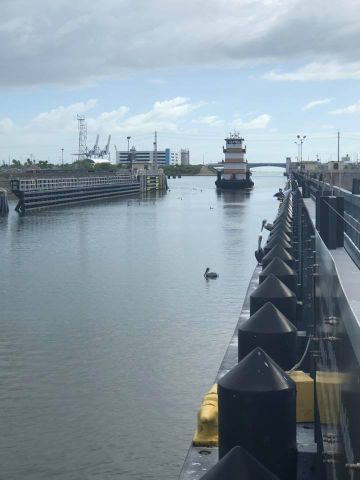Canaveral Lock
Located between Port Canaveral's West turning basin and the Banana River, Canaveral Lock was constructed by the US Army Corps of Engineers in 1965 to secure safe passage of vessels from the Banana River to Port Canaveral and the Atlantic Ocean. The lock reduces tidal-current velocities in Canaveral Harbor, prevents entry of hurricane tides into the Banana River and prevents salt water intrusion. Canaveral Lock, the largest navigation lock in Florida, was built larger than originally planned to allow passage of the Saturn rocket's first stage, used to put Apollo rockets into space.[1]
Location of Canaveral Harbor: 145 miles south of Jacksonville and 70 miles north of Fort Pierce
Canaveral Harbor history: Created in 1951 by an artificial cut through the barrier beach to provide access to a turning basin in the Banana River, jetties completed in 1954
Lift of lock: Varies by tide stage in Canaveral Harbor and water level in the Banana River. Normal maximum difference in water levels is 3 to 4 feet.
How water level is changed: By releasing water from the ocean side to the Banana River side or vice versa
Lock staff: Five Corps of Engineers personnel
Major commodities through lock: Petroleum, NASA Shuttle booster rockets, commercial fishing vessels
Lock usage: Any vessel with draft up to 12 feet, no charge for lockage. Lockage takes 20 to 30 minutes.
Lock cost: $5.6 million total (includes bridges, roads, barge canal enlargement), cost of lock $2.96 million
Gate type: Sector gate (pie-slice shape), similar to gates on the Okeechobee Waterway Gate size: 23 feet high, 54 feet wide, 54 feet across the end
Gate weight: 47 tons (similar to the weight of 40 cars)
Lock chamber type: Earth walls, stone bottom, stone riprap on walls
Water seal type: Rubber cushion
Gate skin plate thickness: 3/8 inch
Concrete in gate monoliths: 15,000 cubic yards
Concrete slab thickness at bottom of gate: 10 feet, widest point between gates is 184 feet
